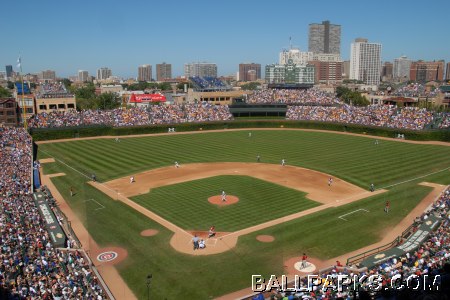Wrigley Field
Chicago, Illinois
Tenant: Chicago Cubs (NL)
Opened: April 23, 1914
First Cubs game: April 20, 1916
First night game: August 8, 1988 (scheduled), August 9, 1988 (official)
Surface: Merion Bluegrass and clover
Architect: Zachary Taylor Davis (1914)
Construction: n/a
Owner: Charlie Weeghman (1914-1916); Chicago Cubs (since 1916)
Cost: $250,000
Chicago Cubs tickets:
Capacity: 14,000 (1914); 18,000 (1915); 20,000 (1923); 38,396 (1927); 40,000 (1928); 38,396 (1938); 38,000 (1939); 38,396 (1941); 38,690 (1949); 36,755 (1951); 36,644 (1965); 37,702 (1972); 37,741 (1973); 37,272 (1982); 38,040 (1986); 38,143 (1987); 39,600 (1989); 38,710 (1990); 38,765 (1994); 38,884 (1997); 38,902 (1998); 41,118 (2006).
Wrigley Field attendance figures
A.K.A.: North Side Ball Park (1914); Weeghman Park (1914-15); Cubs' Park (1916-26); Whales Park (1915); Bobby Dorr's House.
Location: Left field (N), West Waveland Avenue; third base (W), Seminary Avenue; home plate (SW), North Clark Street; first base (S), 1060 West Addison Street; right field (E), North Sheffield Avenue.
Dimensions: Left field: 345 (April 1914), 310 (May 1914), 327 (June 1914), 343 (1921), 325 (1923), 348 (1925), 364 (1928), 355 (1938); left center deepest corner in the well: 357 (1938); power alleys: 364 (1914), 368 (1938); center field: 440 (1914), 447 (1923), 436 (1928), 400 (1938); right center deepest corner in the well: 363 (1938); right field: 356 (April 1914), 345 (June 1914), 321 (1915), 298 (1921), 399 (1922), 318 (1923), 321 (1928), 353 (1938); backstop: 62.42 (1930), 60.5 (1957), 62.42 (1982), 60 (current); foul territory: very small.
Fences: Left-field corner: 15.92 (11.33 brick with Boston and Bittersweet ivy, below 4.59 plywood), 3 wire basket in front 1985 (does not change height of fence); transition between left-field corner and bleachers: 12.5 (screen and yellow railing on top of brick wall); left-center to right-center: 8 (screen, 1914), 11.33 (brick with ivy, 1938); in front is wire basket (May 1970); center-field scoreboard: 40 (wood July 9 to September 3, 1937); center-field screen: 19.33 (8 wire above 11.33 brick June 18, 1963, to October 1964); right-center triangle: 17.5 in front of catwalk steps sloping down to 15.5 (screen 1928, plywood 1979, removed 1985); right-field corner: 15.5 (11.33 brick with ivy, below 4.17 plywood), wire basket in front (1985).
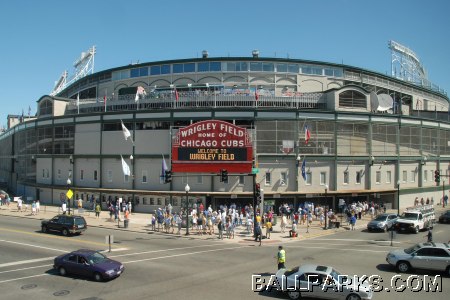 |
The first park on Chicago's North Side, Wrigley Field cost $250,000 when it was built in 1914. Charlie Weeghman built the park to house his baseball team, the Chicago Federals (a.k.a. the Chi-Feds and, later, as the Whales) of the brand-new Federal League, which was challenging the established major leagues. The Federal League folded after only two years, so Weeghman, leading a ten man syndicate which included chewing gum magnate Willam Wrigley, Jr., purchased the Cubs of the National League. The team was moved from West Side Grounds to what was then known as Weeghman Park. In 1918, Wrigley took over Weeghman's share of the team and by 1919 had bought out the shares of the other members of the syndicate. The name of the stadium was changed to Cubs Park in time for opening day, 1920. It was renamed Wrigley Field in his honor in 1926.
The outfield bleachers went up in 1937 and the scoreboard was constructed the same year by Bill Veeck. It is still manually operated, and it still has never been struck with a batted ball, although Roberto Clemente and Bill Nicholson each hit home runs that barely missed. Sam Snead hit it once with a golf ball teed off from home plate. Veeck was also responsible for the ivy that gives Wrigley its distinctive look. In 1937 he planted 350 Japanese bittersweet plants and 200 Boston ivy plants. Eight Chinese elm trees were also planted on the bleacher steps to complement the ivy, but the wind from Lake Michigan kept blowing the leaves off and after multiple attempts at replacing the trees, they were removed.
The first permanent concession stand in baseball was built here in 1914. The custom of allowing fans to keep foul balls hit into the stands started here, as did the custom of throwing back home runs hit by opposing players. "Take Me Out To the Ballgame" has been sung (off-key) thousands of times by venerable announcer Harry Caray (1914-1998), and countless fans have watched the game from the porches and rooftops of the houses on Waveland Avenue (behind the left-field fence) and Sheffield Avenue (beyond right field).
After 5,687 consecutive day games played by the Cubs at Wrigley, the lights were finally lit on August 8, 1988, for a game with the Philadelphia Phillies. That game was rained out after 3½ innings, and the first official night game took place the following evening against the New York Mets. The Cubs won, 6-4. Lights had actually been placed in the ballpark for installation in 1941, but Wrigley instead donated them to a shipyard for the war effort the day after Pearl Harbor. In the late 1980s, however, Cubs management insisted that the team was in danger of leaving Wrigley if lights weren't installed, and Major League Baseball threatened to make the Cubs play postseason games at Busch Stadium in St. Louis.
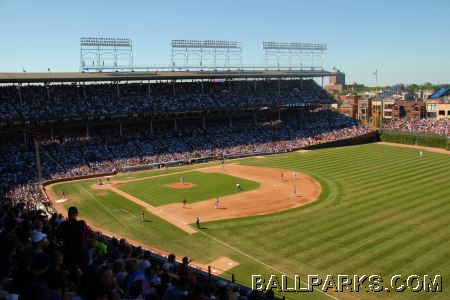 |
Some classic moments in baseball history have taken place at Wrigley, starting with the legendary 1917 pitching duel between Jim 'Hippo' Vaughn and the Cincinnati Reds' Fred Toney. Both threw no-hitters for nine innings (the only such dual feat in the majors) before the Reds' storied Olympian Jim Thorpe drove in the only run. Toney completed his no-hitter. On Sept. 28, 1938, Cubs Hall of Fame catcher Gabby Hartnett hit his famous "Homer in the Gloamin" off the Pittsburgh Pirates' Mace Brown. With the game about to be postponed because of darkness, Hartnett hit a game-winning homer to lift the Cubs to the pennant. Probably no event at Wrigley Field is more famous than Babe Ruth's supposed "called shot" home run off Charlie Root in the 1932 World Series. It is now acknowledged that Ruth did indeed gesture toward the outfield just before depositing Root's pitch into the bleachers, but it may never be known just what he meant. The mystery only adds to the mystique. It was at Wrigley that Ernie Banks hit his 500th homer in 1970 and Pete Rose got his 4,191st hit to equal Ty Cobb's mark in 1985. But the Cubs have never won a World Series title at Wrigley Field, having lost in all six attempts since 1918. Their last world championship came in 1908, six years before Wrigley was built.
Wrigley Field Trivia:
- The only remaining Federal League ballpark, the Federals/Whales played here from April 23, 1914, to October 3, 1915.
- Beautiful ivy vines on the outfield wall.
- Flags with Ernie Banks's uniform No. 14 and Ron Santo's uniform No. 10 fly from the left-field foul pole. Flags with Ryne Sandberg's No. 23 and Billy Williams's No. 26 fly from the right-field foul pole.
- After each game, a white flag with a blue "W" flying from the center-field flag pole signifies a Cubs win, a blue flag with a white "L" a Cubs loss.
- Until the early nineties, the win flag was blue and the loss flag was white. But, it was pointed out that a white flag was the flag of surrender! Jokingly, it was said that the white loss flag was getting weather-beaten from overuse. It was also pointed out that flags honoring Banks, Williams and others had a white background, so all "good" flags should be white.
- Site of the 1990, 1962 (II) and 1947 All-Star games.
- Wrigley is affected by wind conditions more than any other major league park. Breezes off Lake Michigan favor pitchers, but winds blowing toward Lake Michigan take homers with them.
- The center field 400 sign is slightly right of straightaway center field.
- The only park where it's more difficult to hit a homer down the foul line than to hit one 50 or so feet out in fair territory, because the bleachers protrude into the outfield.
- In 1923 the foul lines were shifted slightly because of renovations to the park.
- The left-field bleachers were removed in 1925.
- In the winter of 1926-1927, the grandstand was double-decked, and the playing area was lowered several feet.
- For World Series in 1929, 1932, and 1935, extra bleachers were built on the street on Waveland and Sheffield.
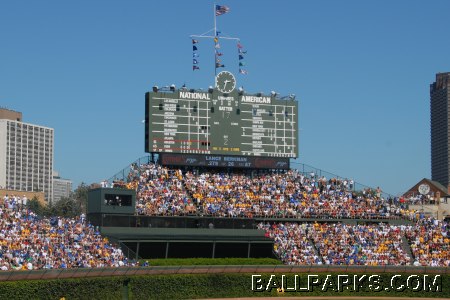 |
- During the 1930s, grounds superintendent Bobby Dorr lived in a six room apartment at the ballpark, adjacent to the left-field corner gate; Cubs traveling secretary Bob Lewis later lived there; the apartment is still there and is now used by the food services group at the park.
- The park was located in such a way that it would be easy for fans to get there on the Milwaukee Road train.
- The 27-foot-high, 75-foot-wide scoreboard was built in 1937 by Bill Veeck. Its top is 85 feet above the field. The 10-foot-diameter clock was added in 1941.
- In 1937 the bleacher stairstep was created to allow potted plants and eight huge Chinese elm trees to grow, complementing the ivy. The trees eventually died.
- Ivy was planted on the outfield walls in 1937 by Bill Veeck, originally 350 Japanese bittersweet plants and 200 Boston ivy plants.
- During the 1937 season the outfield bleachers were expanded to their present size, and the six gates in the brick wall were emplaced. Originally red, they were repainted green in the eighties.
- The famous "Bleacher Bums" were formed here in 1966 by 10 fans.
- The foul area down the right field line was remodeled in 1950-1951, changing the sitelines in that section from pointing toward second base to the pitcher's mound.
- An 8-foot-high, 64-foot-wide batters' background wire fence stood on top of the center-field wall from June 18, 1963, through the end of the 1964 season. It was called the Whitlow Fence because Cubs Athletic Director Robert Whitlow put it up. The screen prevented 10 homers, 4 by Cubs and 6 by visitors and 1 each by 500-plus homer hitters Ernie Banks and Willie McCovey.
- A green Astroturf cover on center-field seats, used for batters' background, debuted on May 18, 1967. It was replaced by rows of evergreen plants in 1997.
- More home runs than usual are caused by the park's relatively high altitude of over 600 feet above sea level and by the heat involved in playing so many day games.
- Water fountain moved to the Cubs Hall of Fame under the first-base stands, near the Friendly Confines cafe. The fountain was closed in by storage area early in
the 1980s shortly after the Tribune Company bought the club.
- Arched dormers on the roof.
- Outfield wall distances before 1981 were marked on plywood markers screwed into the brick. Since then they have been painted directly onto the brick.
- Foul-pole screens have distances marked on plywood vertically: '355' and '353.'
- 226 seats were added in July 1985 to catwalks near foul pole, in fair territory, 119 in the Family Section in left field and 107 in the Group Section in right.
- The Cubs made changes to their ballpark before the beginning of the 1999 season to honor two of the their legendary broadcasters, both of whom had died the previous year. A seven foot tall statue of Harry Caray was erected at the corner of Addison Street and Sheffield Avenue near Gate D, and Jack Brickhouse's trademark "Hey, Hey" was placed above the distance markers on both foul pole screens.
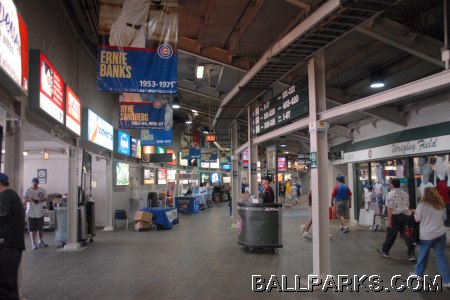 |
More on Wrigley Field:
Recommended Reading (bibliography):
- Wrigley Field: The Unauthorized Biography by Stuart Shea.
- Wrigley Field: A Celebration of the Friendly Confines by Mark Jacob, Stephen Green and Ernie Banks.
- A Day at the Park: In Celebration of Wrigley Field by William Hartel and Susan Smith.
- Wrigleyville: A Magical History Tour of the Chicago Cubs by Peter Golenbock.
- Fodor's Baseball Vacations, 3rd Edition: Great Family Trips to Minor League and Classic Major League Ballparks Across America by Bruce Adams and Margaret Engel.
- The Ultimate Baseball Road-Trip: A Fan's Guide to Major League Stadiums by Joshua Pahigian and Kevin O'Connell.
- Joe Mock's Ballpark Guide by Joe Mock.
- Take Me Out to the Ballpark: An Illustrated Tour of Baseball Parks Past and Present by Josh Leventhal and Jessica Macmurray.
- The Ballpark Book: A Journey Through the Fields of Baseball Magic (Revised Edition) by Ron Smith and Kevin Belford.
- Ballparks: A Panoramic History by Marc Sandalow and Jim Sutton.
- Field of Schemes: How the Great Stadium Swindle Turns Public Money into Private Profit (2nd Edition) by Joanna Cagan and Neil deMause.
- Public Dollars, Private Stadiums: The Battle over Building Sports Stadiums by Kevin J. Delaney and Rick Eckstein.
- Sports, Jobs, and Taxes: The Economic Impact of Sports Teams and Stadiums by Roger G. Noll and Andrew Zimbalist.
- City Baseball Magic: Plain Talk and Uncommon Sense about Cities and Baseball Parks by Philip Bess.
- Diamonds: The Evolution of the Ballpark by Michael Gershman.
- Green Cathedrals: The Ultimate Celebration of All 273 Major League and Negro League Ballparks by Philip J. Lowry.
- Lost Ballparks: A Celebration of Baseball's Legendary Fields by Lawrence S. Ritter.
- Roadside Baseball: A Guide to Baseball Shrines Across America by Chris Epting.
- The Story of America's Classic Ballparks (VHS).
Chicago Cubs
Wrigley Field
1060 West Addison Street
Chicago, Illinois 60613-4397
Help us provide a better web site by completing our feedback form
PHOTOGRAPHS:
All photos © 2007 by Russ Andorka.
Special thanks to Ed Hartig (SABR Ballparks Committee), Kristen Kelly and Eddie Wiese.
Updated May 2008
Tickets to Chicago Cubs, Cubs Cardinals, Cubs White Sox, NCAA Basketball Tournament, College Football Bowl, NCAA Football, Chicago Bears and Paul McCartney provided by Ticket Triangle.
BALLPARKS © 1996-2025 by Munsey & Suppes.
|

